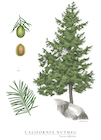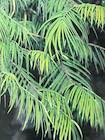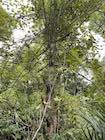Torreya
Arnott 1838
Common names
Torreya, stinking-cedar; 榧'属 fei shu [Chinese], 비자나무 bija [Korean], カヤ, Kaya [Japanese].
Taxonomic notes
A genus of six species:
Syn: Tumion Rafinesque; Caryotaxus Henkel et W. Hochst.; Foetataxus J. Nelson.
A cladistic analysis based on morphological characters places Torreya sister to Amentotaxus, in a clade sister to Cephalotaxus (Ghmire and Heo 2014). Molecular studies likewise place Torreya sister to Amentotaxus, but do not show a close relationship to Cephalotaxus or other genera in the Taxaceae (Cheng et al. 2000, Hao et al. 2008, Zhang et al. 2019). However, infrageneric molecular studies have been inconclusive, with very different findings from the chloroplast and nrITS analysis of Hao et al. (2008) and the more extensive molecular databases analyzed by Wang et al. (2019) and of Zhang et al. (2019). Normally I would place greater confidence in the later analyses, but that of Zhang et al. reaches some rather implausible conclusions, placing T. fargesii sister to T. nucifera and T. californica sister to T. grandis; on biogeographic grounds it seems very likely that there is a fairly close relationship between the North American species. The analysis by Wang et al. (2019) at least is biogeographically plausible, placing T. grandis and T. jackii together in a clade sister to T. nucifera, these three species sister to T. fargesii, and the Asian species sister to the North American ones. Wang et al. (2019) also do a singularly clear job of presenting the complexities of interpreting their findings, which gives their analysis considerable credibility.
Description
Dioecious (rare monoecious individuals) evergreen shrubs or trees. Crowns variable. Bark smooth or flaky, becoming fissured with age. Leaves alternate but pectinate in arrangement, flattened, linear-lanceolate, stiff, coriaceous, sharply acuminate or pungent, with a conspicuous midrib; stomata in two bands on abaxial (lower) side. Pollen cones solitary in the axil of each leaf on fertile shoots, forming double rows on the lower side twigs; sub-globose. Seed-bearing structures consist of a fleshy aril holding a single large seed; they are axillary to foliage leaves, where usually 1-3 sub-terminal, erect ovules form, but only one develops to maturity. The seed is large, hard, with a rigid seed coat enclosed in a fleshy aril that ripens in the second year to a color from purplish green to nearly black. Seedlings have 4 short cotyledons (Farjon 2010).
In general, the species are readily distinguished by examination of the foliage, including the length and width of leaves, the angle at which twigs depart from the branches, and especially the underside of the leaves: the prominence of the midrib, the width of the stomatal bands and their bordering margins, and the character of the leaf margin: flat, raised, or slightly revolute. When available, the ripe arils are also distinctive with regard to size, shape, and coloration. To a practiced eye, the growth forms are also generally distinctive.
Distribution and Ecology
China; Japan; South Korea; USA: California & Florida (Farjon 2010). All species have disjunct distributions, except that there is overlap between T. grandis and T. jackii (q.v.), in which case hybridization and introgression occur.
Remarkable Specimens
The largest and probably the tallest individuals are found in Torreya nucifera, thanks to preservation of some very large specimens as spiritually important trees in Japan and South Korea. Prior to the extensive exploitation that has virtually eliminated large trees from their natural range in China, Japan, and California, comparably large trees likely existed in both T. grandis and T. nucifera, with T. californica a lesser but still impressive tree.
There are almost no good age data. Many trees are claimed to 1,000 and even 2,000 years old in Japan and China, but these are unsupported by any form of evidence. There appear to be no demonstrated ages over 100 years, apart from the very young ages (up to about 200 years) that can be inferred from documented planting records. It is reasonable to infer, from observed growth rates and sizes and the very decay-resistant nature of the wood, that the oldest trees in each species may exceed 500 years, and the largest trees (in T. grandis and T. nucifera) may exceed 1,000 years.
Ethnobotany
Two Asian species, T. grandis and T. nucifera, have been exploited for seed harvest for centuries past, perhaps millennia, and continue to be commercially significant in this regard. The seeds have both food and medicinal value. These species, and China's T. jackii, are used as ornamentals in Asia, though they are rare elsewhere. Some very large T. nucifera are preserved as national natural monuments or spiritually significant trees in Japan and South Korea. All of the larger species (T. californica, T. grandis, and T. nucifera) were formerly important timber trees, producing a lovely light golden easily-worked and decay-resistant wood. Due to overexploitation, harvest of these species has now virtually ceased.
There has been very limited work on the dendrochronology of T. grandis and T. taxifolia.
Observations
See the species accounts.
Remarks
Although T. nucifera had earlier (1712) been described as a species of Taxus, the genus was established with the ca. 1838 discovery, by pioneering American botanist Harvey Croom, of Torreya taxifolia; the genus was named for John Torrey (1796-1873), one of the most celebrated U.S. botanists of the mid-19th century (Eifert 1965). Torrey himself was later (1854) to describe another species in the genus, Torreya californica.
Citations
Cheng, Y., Nicolson, R. G., Tripp, K., and Chaw, S.-M. 2000. Phylogeny of Taxaceae and Cephalotaxaceae Genera Inferred from Chloroplast matK Gene and Nuclear rDNA ITS Region. Molecular Phylogenetics and Evolution 14(3):353–365. doi:10.1006/mpev.1999.0710.
Eifert, Virginia S. 1965. Tall trees and far horizons. New York: Dodd, Mead. 301 p.
Ghimire, B., and Heo, K. 2014. Cladistic analysis of Taxaceae s. l. Plant Systematics and Evolution 300(2):217–223. doi:10.1007/s00606-013-0874-y.
Hao, D. C., Xiao, P. G., Huang, B., Ge, G. B., and Yang, L. 2008. Interspecific relationships and origins of Taxaceae and Cephalotaxaceae revealed by partitioned Bayesian analyses of chloroplast and nuclear DNA sequences. Plant Systematics and Evolution 276(1–2):89–104. doi:10.1007/s00606-008-0069-0.
Wang, Y. J., Xiao, K., and Kou, Y. X. 2019. Torreya jackii (Taxaceae): a special species that is genetically admixed, morphologically distinct, and geographically sympatric with parent species. Forests 10(2):174. https://doi.org/10.3390/f10020174. Open access.
Zhang, X., Zhang, H.-J., Landis, J. B., Deng, T., Meng, A.-P., Sun, H., Peng, Y.-S., Wang, H.-C., and Sun, Y.-X. 2019. Plastome phylogenomic analysis of Torreya (Taxaceae). Journal of Systematics and Evolution 57(6):607–615. doi:10.1111/jse.12482.
See also
Buchholz, J.T. 1940. The embryogeny of Torreya, with a note on Austrotaxus. Bulletin of the Torrey Botanical Club 67:731-754.
Li, J., C.C. Davis, M.J. Donoghue, S. Kelley and P. Del Tredici. 2001. Phylogenetic relationships of Torreya (Taxaceae) inferred from sequences of nuclear ribosomal DNA ITS region. Harvard Papers in Botany 6: 275-281.
Burke 1975.





